What is HDMI eARC?
HDMI is the most preferred method of connecting consumer audio and video devices worldwide. HDMI may look like a regular cable, but it is one of the few common interfaces designed to transmit everything, from audio, video, Ethernet to additional digital signals, at the same time. .
HDMI eARC is an enhanced version of the ARC (Audio Return Channel) protocol that exists in the HDMI standard. This convenient feature implemented in the HDMI standard is a tool that simplifies home theater settings even further, by avoiding the need for more cables. To understand what is different between eARC and ARC, it is important to know the importance of HDMI and the role of ARC in the home theater ecosystem.
HDMI: Reduce unnecessary things in your entertainment room
The dawn of the digital age in the home entertainment space sees many different brands introducing their own proprietary formats, each with cable, connection and technical standards. Separate numbers for communication between devices.
The rear I / O panel of the AV receiver in a mid-range home theater setup will quickly get tangled up by a bunch of cables, like a poorly maintained data center. Major manufacturers soon realized that it would not be possible to make their products appealing to consumers, without eliminating the cables created by fragmented connectivity standards.
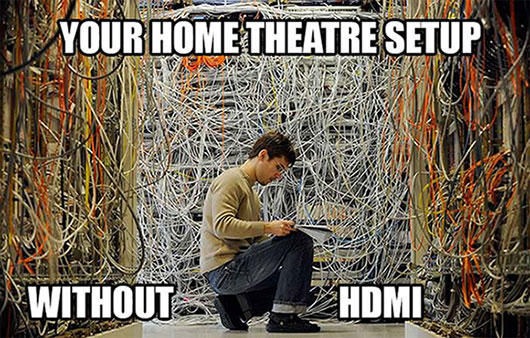 What is HDMI eARC? Picture 1
What is HDMI eARC? Picture 1
The answer to this problem is another proprietary connection standard called HDMI. HDMI is the result of joining forces of seven founding companies and involving an 83-stakeholder electronics forum, to create a truly cable capable of decoding and simplifying the ecosystem. Thai home theater.
This new interface has enough bandwidth to transmit high-resolution video, uncompressed multichannel audio, Ethernet and additional digital data, including related digital handshake process data. to anti-piracy measures, both upstream and downstream. HDMI primarily acts as a single cable that communicates with almost every device in the home theater setup, while eliminating the need for a number of different connections.
What is HDMI ARC?
Although HDMI has been in consumers' homes since 2004, the Audio Return Channel (ARC) protocol was not introduced until 2009 with version 1.4 of the HDMI specifications. The HDMI cable connected to the TV usually receives video and audio signals from a source such as a video game console, Blu-ray player, AV receiver or set-top box. The ARC protocol allows the TV to send 'upstream' audio data to the source device via HDMI cable.
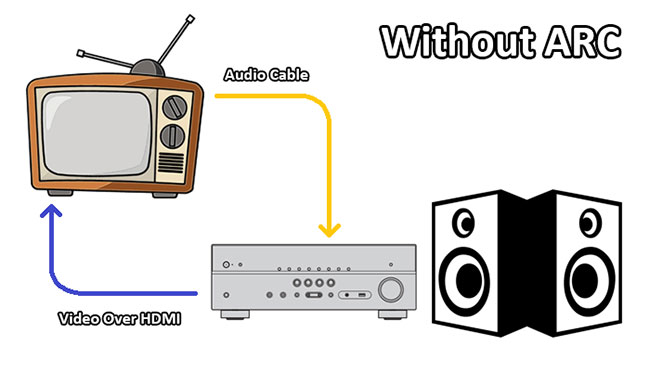 What is HDMI eARC? Picture 2
What is HDMI eARC? Picture 2
Do you need HDMI ARC?
If you own a flat-screen TV, you're probably investing in a speaker system. The speaker system can be anything, from a simple soundbar to a complex AV receiver, hooked up to a large 5.1 channel surround sound setup.
Most consumers use separate optical or coaxial cables to transmit audio signals from TVs to such loudspeaker systems. This is especially true if you want the external speaker system to stream audio from a set-top box connected to a TV, or streaming video applications like Netflix, Amazon Prime Video and Hulu.
HDMI ARC removes the additional optical or coaxial cables necessary to transmit digital audio signals from the TV to the AV receiver (or soundbar). The same type of HDMI cable can be used to transmit video signals from an AV receiver to a TV, to send audio signals from devices connected to the TV (as well as integrated streaming applications) to the speaker setup out.
Anyone who owns the external speaker setup will benefit from HDMI ARC as this is the most convenient and clutter-free means to transmit audio signals from the TV.
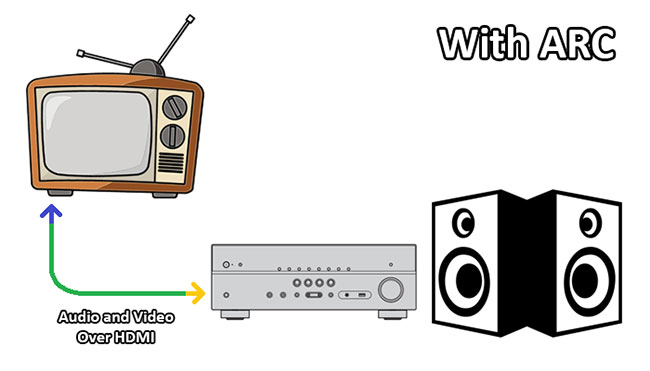 What is HDMI eARC? Picture 3
What is HDMI eARC? Picture 3
HDMI eARC: Taking ARC to a new level
Although the HDMI standard featured automatic lip sync correction 3 years before the introduction of HDMI ARC, its implementation was still optional. Unsurprisingly, the delay in processing between connected devices causes lip-syncing problems, if connected devices have performed lip-sync correction automatic.
This has changed with HDMI eARC. HDMI eARC forces all devices to implement this feature in order to receive eARC certification. Therefore, watching movies will not be an unstable experience with eARC anymore.
HDMI eARC also implements the latest HDMI 2.1 specifications. That means it also benefits from the high bandwidth of the new standard. The old HMDI ARC protocol had enough bandwidth to transmit compressed 5.1 channel audio signals. However, modern uncompressed multichannel audio formats, like DTS-HD Master Audio and Dolby TrueHD, except for more complex object-based formats like Dolby Atmos and DTS: X, cannot be transmitted via tape. throughput of current ARC protocol.
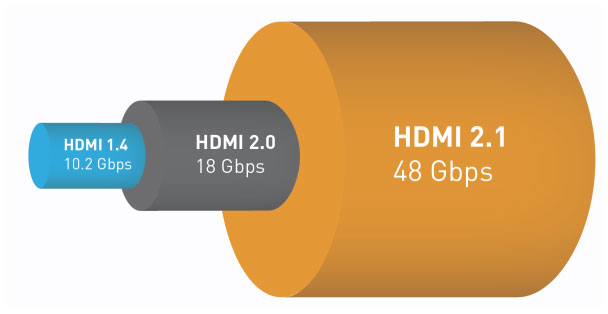 What is HDMI eARC? Picture 4
What is HDMI eARC? Picture 4
This is where the 48Gbps large bandwidth of HDMI 2.1 specifications is utilized, in order to enable HDMI eARC to provide uncompressed audio data with an impressive 24-bit / 192HKz resolution at 38Mbps. On top of that, it also extends the channel limit up to 32 separate audio channels.
The new eARC protocol will not only handle uncompressed digital audio formats, supported by video streaming applications, but also the most bandwidth-consuming formats found on disks. 4K Blu-ray and next generation video game console.
Another lesser-known HDMI feature is Consumer Electronics Control (CEC), which allows various devices to be connected using an HDMI cable to achieve a digital handshake process. This in turn allows the devices to communicate with each other and brings many interesting features, such as allowing users to control the basic functions of multiple devices with a single remote control.
This feature is not stable due to fragmentation, caused by different manufacturers using their own standards. With HDMI eARC, this digital handshake promises to be more stable and seamless.
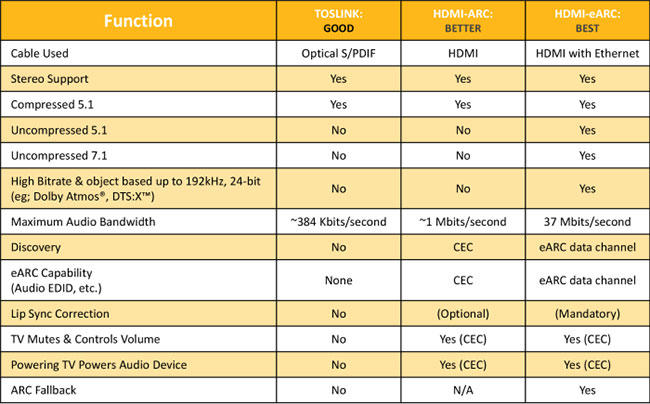 What is HDMI eARC? Picture 5
What is HDMI eARC? Picture 5
What is needed to use HDMI eARC?
At a minimum, you'll need two devices that support the new HDMI 2.1 standard, also including the eARC protocol. For most average consumers, this will involve a TV and AV receiver (or soundbar) that supports the new HDMI 2.1 specification.
In addition, you'll also need an ultra-high-speed HDMI cable to support all the features of the new eARC protocol, especially if you intend to use the highest-resolution video modes supported in the New HDMI 2.1 specifications. However, the existing high-speed HDMI cable with Ethernet capability will also support all eARC features.
Will the new TV (eARC-enabled) work with an old ARC-capable soundbar?
Unfortunately, the official answer from the HDMI forum is just "very likely". HDMI 2.1 specifications do not impose any restrictions on manufacturers to ensure backward compatibility with HDMI ARC protocol, prior to issuing eARC certification. Technically, eARC is not backward compatible with ARC.
 What is HDMI eARC? Picture 6
What is HDMI eARC? Picture 6
The future of HDMI 2.1
However, because there are currently only a handful of devices that support eARC, manufacturers only create new eARC devices capable of communicating with existing ARC hardware. In all likelihood, TVs that support eARC will transmit audio signals to the ARC-compatible soundbar. But certainly do not expect to overcome high-resolution audio signals, only eARC through old ARC hardware.
Because HDMI 2.1 has just been approved, devices like TVs, soundbars, and AV receivers that support it are being introduced gradually. Upcoming PS5 and Xbox Series X video game consoles are also expected to ship with HDMI 2.1, focusing on output resolution.
If you're looking for a new TV and audio / video device, you might want to buy devices with HDMI 2.1 to get ready for the future.
Wish you find a product like that!
You should read it
- Officially released HDMI 2.1 standard that supports 10K video and Dynamic HDR
- Difference between HDMI, Mini HDMI and Micro HDMI
- All things need to know about HDMI 2.1 standard
- What is HDMI-CEC?
- What is HDMI? What is HDMI used for?
- Decoding HDMI sign (STB) on TV
- The 5 best HDMI splitters of 2023
- What is wireless HDMI? Should I use it?
- Learn about HDMI and HDMI switch
- Differentiate DisplayPort and HDMI
- What is HDMI? Instructions for connecting devices via HDMI port
- How to use HDMI-CEC on the Raspberry Pi






 Difference between HDMI, Mini HDMI and Micro HDMI
Difference between HDMI, Mini HDMI and Micro HDMI Officially released HDMI 2.1 standard that supports 10K video and Dynamic HDR
Officially released HDMI 2.1 standard that supports 10K video and Dynamic HDR Distinguishing HDMI 2.1, 2.0 and 1.4
Distinguishing HDMI 2.1, 2.0 and 1.4 What is HDMI-CEC?
What is HDMI-CEC? What is HDMI? What is HDMI used for?
What is HDMI? What is HDMI used for? All things need to know about HDMI 2.1 standard
All things need to know about HDMI 2.1 standard